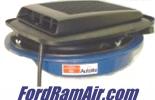There has been a lot of discussion on 460 cams, roller vs. flat tappet, and I was wondering if anyone had noticed the same thing as I have seen on my 460 with aluminum CJ heads. The 351C and 460 heads both have canted valves and because of the angles between the intake and exhaust valve in the same cylinder, the valves can collide under certain levels of lift where both valves are off their seats, i.e. the overlap period. I wondered about this when I was building my first 460 and I actually checked for interference between the intake and exhaust valve during overlap by installing the cam, lifters, pushrods and rocker arms for one cylinder, and a head with weak springs installed. There was no crank or pistons, just the cam and one head. Once adjusted for lash, I turned the cam to the overlap point and measured the closest point that the valves came to one another with a feeler gauge, accessing the combustion chamber through the bottom of the cylinder bore. I was very suprised to find that the valves came within a couple thousandths of touching.
In fact, when I later freshened the motor, I saw that the outer perimeter of the exhaust valves had little dings all around the circumference, indicating that under operating conditions, with expansion and all, the valves were contacting one another.
Now this was not a particularly stout cam. Lunati #41607 flat tappet, 0.572I/0.577E net lift, 265I/272E duration at 0.050" lift and 108 deg C/L, installed straight up.
It would seem to me that a cam with more lift would have an even greater likelyhood of experiencing valve collisions in overlap since the valves are likely to be further off their seats when they pass one another. Perhaps the faster ramp on a roller cam minimizes the danger zone, and the effect is greatest on a flat tappet which is pushing the envelope of available duration?
I know that Ford SVO was concerned about this issue when they came out with the 514 crate motor. That year, they changed the intake valve size on the CJ head from 2.25 to 2.19, supposedly for this very reason, since they installed a roller cam with more lift and duration than the hydraulic cam in the 460/535HP.
Anyone have any ideas on this?











 Mustangsandmore Forums
Mustangsandmore Forums

 Ford Racing
Ford Racing

 460 (and 351C?) cam overlap
460 (and 351C?) cam overlap


